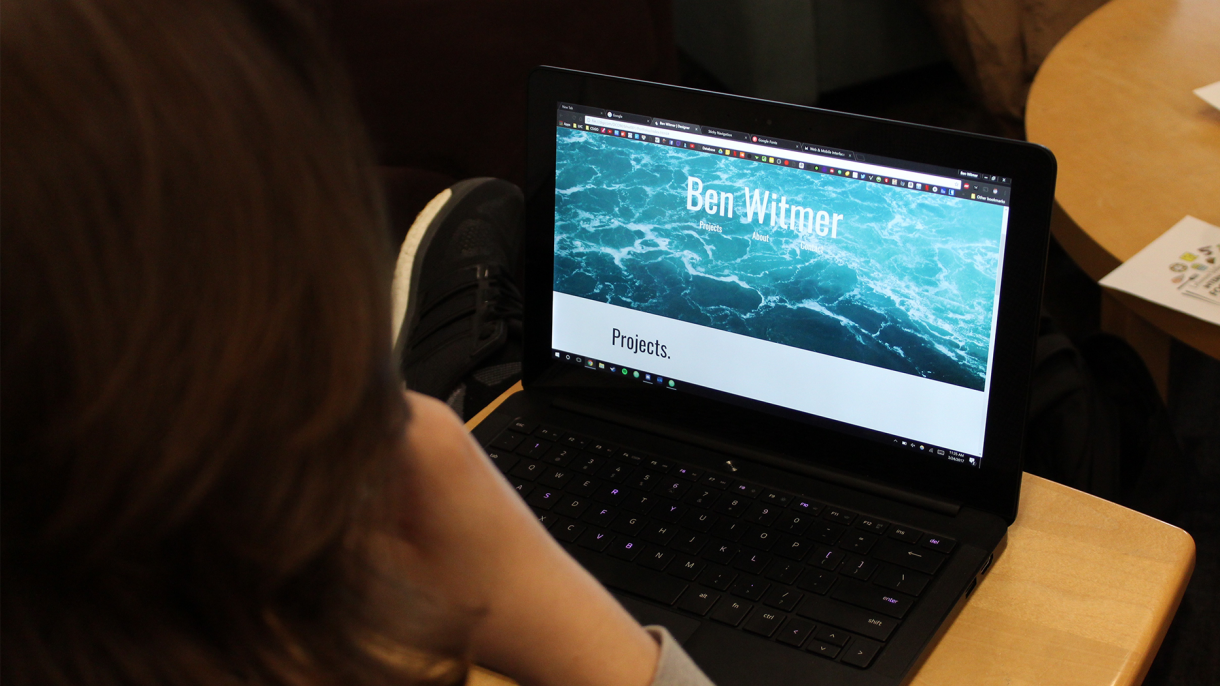
Digital Media Portfolio Guidelines
Portfolio Defenses (DCOM 099) is the prerequisite for taking the student’s Internship (DCOM 400). Digital Media students are required to present their digital portfolio to their classmates and professors. The purpose is to ensure that all students are adequately prepared to enter the workforce and showcase students’ skillsets, thinking, and preparation in the core and concentration.
Content
The portfolio should contain a minimum of nine works, at least two works will deal with the concentration and the remaining seven works should be drawn from and represent the breadth and integrated nature of the courses in the core. In the likely instance in which a portfolio contains group projects, students must honestly explain their contribution to these projects.
The work/projects drawn from the core must be from all six concentrations, as well as DCOM 130 Principles of Information Design and DCOM 131 Usability Design and Testing. The purpose of the works drawn from the core is to:
- demonstrate competency of the material covered across the core
- show how student work successfully integrates principles/ideas of the courses in the core
- provide insight into the student’s competency in the principles of Human-Centered Design and Usability
The work that is drawn from the proposed concentration must demonstrate a mastery (or potential mastery) of the principles and skills covered in that concentration.
Schedule
Students ordinarily present their portfolio in the spring of their sophomore year. Students have the option to defer presentation of their portfolio until their senior or junior year if they transferred or declared after their freshman year. Deferment requires the chair’s permission. The registration signup sheet will be posted in the Digital Media studio.
Process
Students will present their portfolios. All presentations will be video recorded. Faculty vote on the grade to assign the portfolio: pass with distinction, pass, pass with revision, fail. Guests invited by Digital Media faculty to observe and critique student portfolio presentations may comment but are non-voting.
The four possible grades for portfolio presentations are:
- Pass with Distinction– Exceeds expectations, as established in the rubric. Unanimous vote required. (Grade awarded is S/satisfactory.) All students who earn pass with distinction are also awarded the Digital Media Creative Excellence Award.
- Pass– Meets expectations, as established in the rubric. Simple majority vote. (Grade awarded is S/satisfactory).
- Pass with Revision—Fails to meet expectations, as established in the rubric. Simple majority vote. If students receive a pass with revision and already have arranged an internship, they must revise their portfolio before the start of their internship if they want to receive DCOM 400 credit for the internship. (The grade awarded for DCOM 099 will be incomplete until the revisions are successfully completed). Students are obligated to revise their portfolio and receive the Digital Media faculty’s signature, indicating the faculty’s approval of the revisions, before the start of the following semester’s classes. Students who fail to meet the deadline for successfully completing their required revisions in DCOM 099 cannot register for DCOM 400 until they successfully take DCOM 099 again. Students must successfully pass DCOM 099 and DCOM 400 in order to graduate with a Digital Media degree.
- Fail—Fails to meet expectations, as established in the rubric. Requires a unanimous vote. If the faculty vote is not unanimous, the default grade assigned will be pass with major revision. If a student does not pass their portfolio presentation in their junior year, they can present again fall semester of their senior year. If a student fails twice or chooses not to present after failing, the student cannot take DCOM 400 nor graduate with a Digital Media degree. (The grade awarded for DCOM 099 would be U/unsatisfactory).
Portfolio Evaluation Rubric
The Portfolio Evaluation Rubric used to evaluate student portfolio presentations in the following five areas:
The Pitch–How well the student argues ”Why I should stay in Digital Media as an X concentrator.” Arguing this position requires that students: a) explain what is included and why it is in the portfolio, and b) accommodate or refute any objections to the materials presented. The evidence for this argument will be incorporated into their presentation and included in their portfolio. As part of including this information in the portfolios, students are responsible for creating/providing excerpts of their works, explanatory captions and executive summaries of longer works, (with full documents/projects included as appendices). You have five minutes to present and five minutes for Q&A.
- for a pass with distinction—exceeds expectations in providing a cogent, well-supported and explicit justification.
- for pass—provides a convincing, supported justification.
- for a pass with revision—convincing, but lacks cohesion or has serious flaws in argument or support.
- for fail—Argument is unconvincing; it lacks justification and support.
Breadth—work across the core of the major.
- for a pass with distinction–the student demonstrates mastery of the ideas/skills in all courses in the core.
- for pass–student demonstrates competency in the ideas/skills in the core in 3/4 of the courses.
- for a pass with revision—students demonstrate competency in only two of the concentrations in the core.
- for fail—No obvious competency in the core.
Depth—work in the concentration
- for a pass with distinction–student demonstrates mastery of the ideas/skills in the proposed concentration.
- for pass–student demonstrates potential mastery in the ideas/skills in the concentration.
- for a pass with revision—the student demonstrates competency in the concentration.
- for fail—No obvious competency in concentration.
Execution—How well the portfolio is put together/craftsmanship of the portfolio
- for a pass with distinction—format, and media are appropriate for concentration, craftsmanship, and presentation of materials is professional and high quality.
- for pass—format and media are appropriate for concentration, craftsmanship, and presentation of materials is professional and high quality.
- for a pass with revision—format and media are inappropriate for concentration, craftsmanship, and presentation of materials is unprofessional; the quality of the portfolio detracts from the works.
- for fail—format and media are inappropriate for concentration, craftsmanship, and presentation of materials is unprofessional/amateurish; the quality of the portfolio detracts from the works.
Presentation of the portfolio–the appearance and professionalism of the actual presentation. Included within this is speaking, elocution, preparation, professional attire, etc.
- for a pass with distinction—exceeds expectations in all categories.
- for pass—professional. Adequately meets expectations in all categories.
- for a pass with revision—inadequate. Fails to meet expectations in half of all categories.
- for fail—unprepared, unprofessional.


